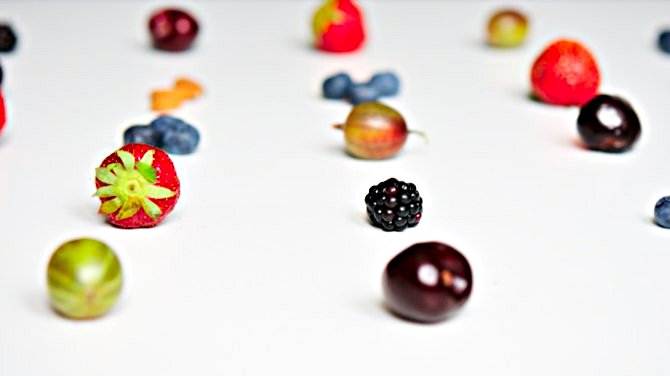
When you visit a supermarket, you are always greeted with a marvelous display. No matter the season, the produce section is filled with fruit and vegetables in all colors of the rainbow. But when you take the alluring fruit home and bite into it, more often than not you notice that it was bred for looks and not for taste. The fact that it is often grown in greenhouses, where the heat is sufficient but the light is not, and picked unripe, to better withstand long transportation routes, doesn’t help either. Ultimately, if you want taste, you have to head to the farmer’s market, where you can get abundant fruit, in season and grown locally; and if you want good fruit in the winter, you have to preserve it.
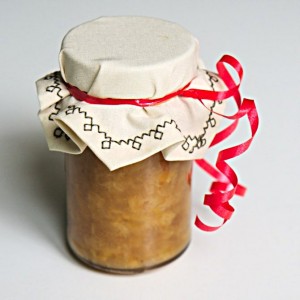
Put a little thought into the packaging, and you can give gifts with a personal touch
While even the simplest strawberry jam can brighten a winter day, it is easy to tire of the same old few sorts all winter long, and start longing for Ray Bradbury’s “summer on the tongue.” Jams, jellies, preserves and syrups—they are the true “summer caught and stoppered”. They make great bread spreads, cake fillings, or also presents with a personal touch. In this series of posts, I will share the unusual, exotic, and varied ones I know of, ones you won’t find in your local supermarket, giving one recipe for each taste-improving idea, and mentioning some other jamsof the same kind for inspiration. While none of them are radically new, I am including some rare recipes, so even if you have been making jams for years, you are likely to come across new ideas. Even if you’re a novice, don’t worry. I don’t explain the basics of jam cooking and canning in this post, but they are easy, and the notes at the end will help you get started.
Today, three ideas: make a conventional jam from an unconventional fruit, make a herb jelly, and use alcohol to bring out the flavor of the fruit.
Unconventional fruit
Everybody has had strawberry jam and apricot jam. But you can make jam out of every fruit, and they’re all tasty. Even fruit which is normally too sour or dry to eat raw can be transformed into a sweet melt-in-your-mouth jelly or jam: try gooseberry jam, redcurrant jelly, or medlar jam. Even if you don’t have a source for these fruits, you still have more options than the usual drupes and berries. Take the banana: a fruit which is common everywhere today, but undeservedly overlooked for preserves. Use ripe bananas for this one, a bit on the brownish side is better than slightly green ones.
Banana jam
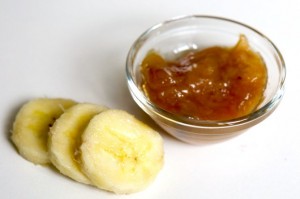 0.5 kg peeled bananas (approx. 4 bananas)
0.5 kg peeled bananas (approx. 4 bananas)- 100 ml oz lemon juice (approx. 3 lemons)
- 100 ml water
- 250 g raw sugar
- pectin
Slice bananas. Put everything into a pot and cook until it gels, stirring from time to time (not too vigorous or you will mash the bananas).
Use alcohol in jams
Alcohol is a great ingredient for jams. Not only does it add its own flavor, the same way it does in baking, but its power as solvent lets you draw out even more flavor from the fruit. You can add alcohol to practically any jam, 20-30 ml per 500 g fruit is enough to bring out the taste without making it boozy. It isn’t hard to match the taste you want; you can go with a traditional combination like rum for most tropical fruits, or combine similar tastes, for example adding creme de cassiss to any berry jam. An example:
Blackberry-vanilla-bourbon jam
- 450 g blackberries
- 150 g sugar
- 30 ml bourbon
- 1 vanilla pod
- pectin
Mash the blackberries. For seedless jam, strain them. Add the sugar, lemon juice, bourbon, the scratched vanilla mark and the opened vanilla pod and cook. Add pectin and cook until gelled, removing the foam when it builds up. Fish out the vanilla pod.
Herbal jellies
 Fruit goes well with herbs—try rosemary-pear jam for example, or apricot-basil. But herbal jellies? You probably have had them if you are British. If not, try them. They are made from a herbal tea, without adding the actual leaves, and they can be eaten either as a sweet jelly with bread or yogurt, or in a savory combination. You can make them with most herbs—rosemary, lemon balm, thyme all make great jellies. The sage jelly listed here is classically combined with lamb roast.
Fruit goes well with herbs—try rosemary-pear jam for example, or apricot-basil. But herbal jellies? You probably have had them if you are British. If not, try them. They are made from a herbal tea, without adding the actual leaves, and they can be eaten either as a sweet jelly with bread or yogurt, or in a savory combination. You can make them with most herbs—rosemary, lemon balm, thyme all make great jellies. The sage jelly listed here is classically combined with lamb roast.
Sage jelly
- 200 g fresh sage
- 50 ml lemon juice
- 400 g water
- 250 g sugar
- food coloring (optional)
- pectin
Bring the water to a boil. Cut the sage leaves and stems and bruise them with a pestle (don’t mash them to small pieces, you just want to break up the outer cell layer). Pour the boiling hot water over them and let them sit for an hour. Strain the sage tea, add the remaining ingredients and cook until it has reached the desired thickness.
Off to the market!
Remember, the recipes here are just examples. As most jams are just the same base recipe, it is very easy to mix-and-match. Get your basked, head to the market, and return with the ripest and sweetest fruit you can get. And don’t forget to tell us about the best combinations in the comments!

Notes
- Not all jams in this series are certain to have the needed acidity for hot water canning! Measure their pH and if it is above 4.5, you can either use pressure canning or keep them in the fridge. For more information on food safety and canning, see this official information on canning safety
- I intentionally didn’t include pectin amounts in the recipes. The amount of pectin you use is dependent on the type and brand of pectin you buy. Use the guidelines printed on your pectin package, or learn more about pectin.
- If you want a small primer on the difference between jam, jelly and preserves, The Kitchn has a great article.
Filed under desserts
Tagged: cherry-berry-nut, jam, jelly




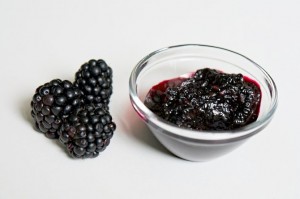
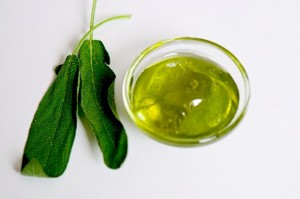
You have some very nice photos to go with the post. Makes it very enjoyable to read!
I’ve tested the different ways to make a herbal jellies. One of the things I’ve tested are the parsley jellies mixed with honey and a water. The other mix I’ve made is my favorite one, it is the Indian basil(tulsi)where I learned from http://organicindia.mercola.com/tulsi-tea.aspx and then mixed it with honey and lemon juice. I just followed your instructions and I really love it!
Glad to hear that it worked for you. I haven’t tried parsley, but it sounds like an interesting solution, probably good for savory applications too. Alternative sweeteners (like honey, but also others) will be covered in a future post of this series.